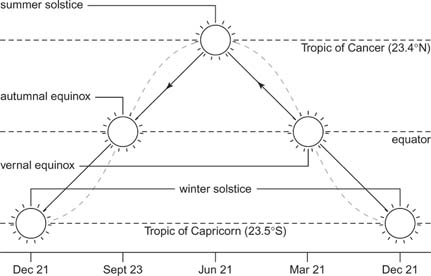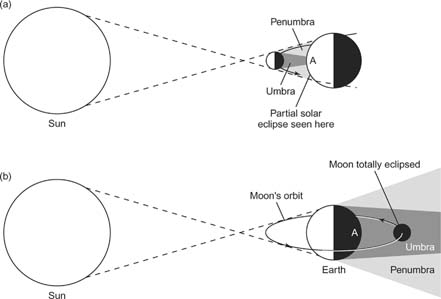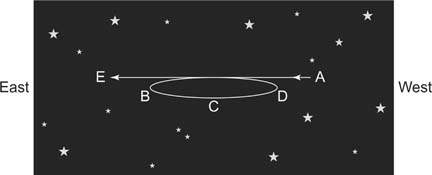Human awareness of the universe began when people realized that they could observe objects in the sky, and that what they saw changed over days, months, and years.
The sky
To any observer on the ground looking at the sky with the naked eye, the sky appears to be a vast spherical bowl, a celestial sphere that extends from all points along the horizon to the zenith, the point directly overhead.
Astronomical objects seen in the sky are so far away that observers viewing them without the aid of a telescope have no intuitive sense of which objects are closer than others. This lack of depth perception causes everything to appear equidistant on the sky. Any object's position on this sphere can be determined by two coordinates, which designate the object's horizontal and vertical location. The vertical coordinate is determined by measuring an altitude angle upwards from the nearest point on the horizon, and the horizontal coordinate is established by measuring an azimuth angle from due north eastwards along the horizon to that nearest point. This system is called either the horizon coordinate system or the alt‐azimuth system (see Figure 1).

Figure 1
The horizon coordinate system.
Stars and constellations
About 6,000 stars are visible to the naked eye when you can achieve the darkest conditions. The positions of the stars relative to each other remain fixed from night to night and year to year. In general, stars in the same area of the sky have no physical relationship to each other, but the very human tendency to impose order upon otherwise random distributions yields patterns of brighter stars, or constellations. Many constellations of the Northern Hemisphere have been inherited from antiquity, including Ursa Major, the Big Bear, of which the more familiar Big Dipper is part, and Orion, the hunter, which can be seen in the winter sky. Many Southern Hemisphere constellations were defined in the last century to fill in unlabeled regions of the sky.
The sky is now officially divided into 88 constellations, which are used in modern astronomy for naming purposes. For example, the star alpha Ursa Majoris (α UMa) is located in the Big Bear constellation. Therefore, Ursa Majoris comes from the name of the constellation, Ursa Major, and the Greek letter α indicates that it's the brightest star within that constellation. In addition to modern names, some 90 or so stars also have names from antiquity. For instance, α UMa is also known as Dubhe.
Over the course of the night, stars move across the sky from east to west as a consequence of Earth's rotation on its axis. The stars appear to move in circular paths around a celestial pole, or either of two points on the celestial sphere where the extensions of Earth's axis would intersect. In the Northern Hemisphere, the celestial pole is coincidentally marked by the relatively bright star alpha Ursa Minoris, also known as Polaris. Simple geometry shows that the altitude angle of the pole star above the northern horizon is equivalent to the latitude of the observer on Earth.
To an observer in the Northern Hemisphere, stars that are always above the northern horizon are known as circumpolar stars; an observer in the Southern Hemisphere would see circumpolar stars around the south celestial pole. Stars that are further to the south and that rise and set sometime during the night are called equatorial stars. Equatorial stars rise in the east, move diagonally into the southern sky, achieving their highest position above the horizon on the meridian (the great circle that extends from due north on the horizon, through the zenith, to due south on the horizon). From the meridian, these stars move westward until they set below the western horizon.
The celestial equator is that great circle formed on the celestial sphere by extending the plane of the Earth's equator. The equator intersects the horizon due west and due east. An immediate consequence of Earth's rotation is identifying the preferred directions of north, south, east, and west around the horizon, called cardinal directions, by which humans naturally orient themselves.
Minute by minute, over the course of the night, both the altitude and azimuth of a star continually change. To more easily observe and track celestial objects, scientists have defined celestial coordinate systems that are fixed upon the sky and thus move with the stars. The equatorial coordinate system is a projection onto the sky of Earth's latitude and longitude coordinate system. Celestial latitude, known as declination, is the angular position north or south of celestial equation. Celestial longitude, measured around the celestial equation, is known as the right ascension (see Figure 2). Declination is measured in degrees, minutes of arc, and seconds of arc. Recognizing that the stars appear to move once around the sky in one day (24 hours), right ascension is measured not in degrees, but in hours, with 24 hours of right ascension (to distinguish from 24 hours of time) equal to 360 degrees.

Figure 2
Celestial sphere features.
The Sun
Like the stars, the Sun rises and sets every day. However, unlike the fixed motion of the stars, the Sun's daily path across the sky varies throughout the year. Twice annually, at the vernal equinox (about March 21) and the autumnal equinox (about September 21), the Sun's position coincides with the celestial equator; it rises due east, moves across the sky following the path of the equator, and sets due west (see Figure 3). At this time of year, the length of the day is the same as the length of the night. During the summer, however, the solar position is north of the equator, achieving a maximum northernmost declination of +23.5 degrees at the time of the summer solstice, around June 21. In the winter, the solar position is reversed, with the Sun at its maximum southernmost declination of –23.5 degrees at the time of winter solstice, December 21. The terms equinox and solstice mark not only specific times of the year, but also specific points in the sky. The vernal equinox is that position on the celestial equator where the Sun crosses from the southern into the northern sky. Celestial longitude (right ascension) is measured eastward around the equator from this point.

Figure 3
The Sun's seasonal positions in the sky.
Relative to the background stars, the Sun also moves about one degree eastward each day, thus encircling the sky in the course of a year. This ecliptic, or the great circle on the celestial sphere defined by the solar path, is tilted with respect to the celestial equator by 23.5 degrees. Throughout the year, the ecliptic passes through the 12 zodiacal constellations. Because the apparent solar movement is caused by Earth's motion around the Sun, the ecliptic plane is also a projection of Earth's orbit about the Sun. That Earth's rotational equatorial plane does not perfectly match its orbital plane (the ecliptic plane) about the Sun is directly responsible for the annual north‐south movement of the Sun and the consequent seasons.
The length of the year is based on the time that the Sun takes to complete its annual path around the sky. During the year, the stars and constellations visible at night change as the seasons pass through their cycle. A year is, in fact, 365.25 days long. To keep the calendar in sync with the actual seasonal passage of time, every four years we have a leap year, or a year of 366 days. The additional day, February 29, makes up for the time lost annually when the 365.25 day cycle is computed as 365 days.
The length of a day is based on the time it takes for the Sun to complete its daily path across the sky, from its crossing of the meridian at noon to its next crossing of the meridian the next day. Daily time based on the hourly position of the Sun in the sky, relative to its noontime position each day, is called apparent solar time.
To astronomers studying the stars, however, the time of day alone is not a sufficient method for determining which stars can be observed at any given time. Astronomers need to know both the time of day and where the Sun is in the sky to find out which stars they can observe. More specifically, what is of interest to an astronomer is the sidereal time, or the right ascension of the stars that are crossing the meridian at any moment. Sidereal time and solar time are not equal because of the annual motion of the Sun across the sky. The true rotation period of Earth is 23 hours, 56 minutes, but the length of the day is four minutes longer. In one rotation of Earth, the Sun has moved roughly one degree across the sky, thus Earth has to rotate a little bit longer to get the Sun back to the same position on the sky. The solar day is 24 hours long.
The actual length of any given day varies throughout the course of the year for two reasons. First, Earth's orbit around the Sun is not a circle, but an ellipse. The Sun's apparent motion across the sky therefore varies slightly, moving more than the average one degree per day in January, but a bit less than the average in July. Second, the solar motion along the ecliptic moves parallel to the celestial equator at the times of the solstices when the Sun is farthest north or south of the equator, but at the times of equinoxes, its motion is at an angle to the celestial equator. What is important for the length of the day is only that part of the solar motion parallel to the equator. This produces a second variation to the length of the day.
The difference between apparent solar time (which would be shown by a sundial) and mean solar time (which would be shown by a clock or watch) is called the equation of time. This is a complicated effect involving orbital mechanics (the motion around an ellipse is not uniform), perspective (a moving object closer to the observer has a greater apparent motion), the tilt of the ecliptic to the equator (hence the daily component of solar motion across the sky varies from equinox to solstice), and a geometrical factor resulting from the fact that we are dealing with a spherical coordinate system; this latter you can demonstrate to yourself by placing your thumb on the equator of a globe. Note how much longitude angle it covers. Now place your thumb near the north pole. Your thumb will cover the same area, but as measured in longitude, it covers a much bigger longitudinal angle. And it's that angle that is important for rotation and hence the length of a day. Noon, as defined by mean solar time, can occur as much as 16 minutes late in October or 14 minutes early in February compared to the Sun's actual crossing of the meridian.
Observation of the Moon shows that it not only appears to change its position by moving around Earth, but at the same time, the fraction of its surface that is illuminated by sunlight (its phase) also changes (see Figure 4). When the Moon is directly opposite the position of the Sun, it appears totally illuminated, or in full phase. When the Moon is viewed at an angle of 90 degrees from the position of the Sun, its surface appears half illuminated, or in its quarter phase. Between full and quarter Moon, the phase is said to be gibbous. If less than half the Moon is illuminated by sunlight, the phase is crescent. When the Moon is in the direction of the Sun and the side toward Earth is its dark or shadowed half, the Moon is said to be new. The cycle from new Moon waxing (increasing illumination) to first quarter to full Moon, then waning (decreasing illumination) to third quarter and back to new Moon takes 29.5 days, a period adopted as the basis of our calendrical month. The lunar phases are observed because of the changing geometrical orientation between the Sun, Moon, and Earth over the course of the lunar month, not the result of Earth casting its shadow on the Moon.

Figure 4
Phases of the Moon.
The Moon takes 27.3 days to move once (360 degrees) around Earth as determined by its orbital position relative to the stars; the orbital period is therefore also an example of a sidereal period, a period measured relative to the stars. This 27.3 days can also be called a sidereal month. The time from full Moon to full Moon is longer, 29.5 days, because two motions are involved: the motion of the Moon around Earth and the motion of Earth around the Sun. To become full again, the Moon must move more than 360 degrees around Earth. The lunar month, or lunation, is thus an example of a synodic period, or a period produced as the consequence of two motions. The term synodic month is also applied to this 29.5 day period. Another example of the difference between a sidereal period and a synodic period is the rotation of Earth (23 hours, 56 minutes) and the length of a day (24 hours).
The actual path across the sky of the Moon is quite complicated. The lunar orbital plane is tilted about 5 degrees 9 minutes with respect to ecliptic plane. The orientation of these two planes rotate with respect to each other over an 18.6 year period. In consequence, relative to the celestial equator, the lunar orbital plane has a variable tilt that periodically oscillates from 23.5 degrees minus 5 degrees 9 minutes equals 18.3 degrees, to 23.5 degrees plus 5 degrees 9 minutes equals 28.7 degrees. In other words, over the course of the month, the Moon can oscillate north and south across the celestial equator between declinations of as little as ±‐18.3 degrees to as much as ±‐28.7 degrees. Each month the path of the Moon across the sky differs slightly from its path the prior month and from its path the next month. In contrast, each year the solar path around the sky is essentially the same.
Astronomers find particularly interesting the two intersection points, or nodes, between the great circles of the ecliptic plane and the lunar orbit. If the Sun and Moon in their motions about Earth move simultaneously through nodal positions, an eclipse occurs (see Figure ). If the Moon and Sun are at the same node, the Moon passes in front of the Sun and a solar eclipse results, lasting only a few minutes in duration. If the two are at opposite nodes, then the Moon passes through the shadow of the Earth and a longer duration lunar eclipse occurs. The cycle of occurrence of eclipses is quite complicated because three factors are involved. The Sun moves around the sky in 365.25 days. The Moon moves once around the sky every 27.3 days. The direction to a node (where the two orbital planes intersect) moves around the sky in 18.6 years. To get an eclipse, all three positions (Moon, Sun, and node) have to be along a straight line through Earth. This event does not happen with a simple pattern of regular time intervals.

Figure 5
Solar and lunar eclipses.
Naked‐eye observers in antiquity recognized five other objects that move across the sky relative to the stars — the planets. The word planet comes from the Greek, meaning “wanderer.” Planetary motion is more complicated than that of the Moon or Sun, which move systematically west to east relative to the stars. The planets' usual motion is west to east, termed direct or prograde motion. But in each synodic period, planets show a brief period of motion in the opposite or retrograde direction.
Retrograde motion is the result of perspective. Consider, for example, driving on a freeway. You look forward toward a slower moving car. Relative to the distant mountains, it is clear that this car is moving in the same direction you are moving. But as you catch up to and bypass the slower car, you see it appear to be moving backwards compared to the distant horizon. As you pull ahead, once again looking back at the slower car shows it to be moving forward. Observation of other planets from Earth produces the same apparent reversal of motion relative to the background of stars. (See Figure 6).

Figure 6
Retrograde motion. A planet displaying retrograde motion appears to briefly move east to west rather than west to east.